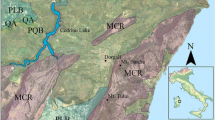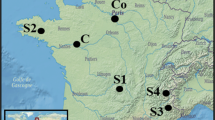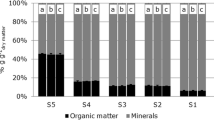Abstract
Purpose
Anthropic-accelerated erosion processes have led to an increase in reported loss of soil surface horizons worldwide. Lake-dredged materials (LDMs) have often been considered suitable for upland disposal. This study aimed to assess the potential beneficial use of LDMs in soil rebuilding strategies for Mediterranean soils affected by the loss of surface horizons with consequent erosion/entisolization processes.
Materials and methods
Different model proto-horizons (MPHs) were assembled by means of the co-utilization of LDMs, other mineral matrices, organic amendment, and mineral fertilizer for the growth of a pasture grass under controlled (pot) conditions. The evolution of nine different MPHs was monitored by means of an evaluation/comparison of several physical–chemical parameters (texture, pH, electrical conductivity, N, P, K, and cation-exchange capacity) and the stability-modification of organic matter (OM) quality in relation to plant development (dry matter production, agronomic efficiency, and plant cover).
Results and discussion
The addition of LDM resulted in statistically significant (p < 0.05) improvement to both plant performance and several soil physical–chemical properties. Compared with the reference soil (degraded soil without any additional treatment), the model proto-horizons treated with the highest LDM content (50 % w LDM without any additional treatment) showed the largest total dry matter production, the highest agronomic efficiency, and a quali-quantitative increase in plant cover. A more balanced texture (loamy) and a generalized increase in total organic carbon, cation-exchange capacity, N, and K were also detected with particular reference to models treated with the higher LDM content. Humic substances greatly increased in the treatment with the higher LDM amounts showing a generalized soil organic matter equilibrium, i.e., no mineralization or humification process prevalence.
Conclusions
This study showed that there is indeed the possibility of turning what is currently an awkward refuse material into a commodity that can be properly and advantageously used in pedotechniques for soil rebuilding and land recovery and protection. From this standpoint, LDM would appear to be apt for inclusion on a possible list of useful pedotechnomaterials.





Similar content being viewed by others
References
Aru A, Baldaccini P, Vacca A, Delogu G, Dessena MA, Madrau S, Melis RT, Vacca S (1991) Nota illustrativa alla carta dei suoli della Sardegna. Dip. Sc. Terra Univ. di Cagliari, Ass. Reg. Progr. Bil. ed Asset. Terr., Cagliari
Bish DL, Ming DW (2001) Natural zeolites: occurrence, properties, applications. Mineralogical Society of America and the Geochemical Society, Reviews in Mineralogy and Geochemistry, 45, Washington DC
Brady NC, Weil RR (2008) The nature and properties of soils, 14th edn. Pearson International Edition Inc., Upper Saddle River
Buondonno A, Grilli E, Capra GF, Glorioso C, Langella A, Leone AP, Leone N, Odierna P, Vacca S, Vigliotti RC (2013) Zeolitized tuffs in pedotechnique for the reclamation of abandoned quarries. A case study in the Campania region (Italy). J Environ Manag 122:25–30
Capasso S, Salvestrini S, Coppola E, Buondonno A, Colella C (2005) Sorption of humic acid on zeolitic tuff: a preliminary investigation. Appl Clay Sci 28(1–4):159–165
Capasso S, Colella C, Coppola E, Iovino P, Salvestrini S (2007) Removal of humic substances from water by means of calcium-ion-enriched natural zeolites. Water Environ Res 79(3):305–309
Capra GF, De Riso S, Buondonno A, Vacca S (2008) The influence of the short-term land use change on soil evolution in the centre-south coastal areas of Sardinia. In: Gabriels D, Cornelis WM, Eyletters M, Hollebosch P (eds) Combating desertification. Assessment, adaptation and mitigation strategies. UNESCO Chair of Eremology, Belgian Development Cooperation, pp 74–81
Capra GF, Buondonno A, Coppola E, Duras MG, Vacca S, Colella C (2011) Zeolitized tuffs in pedotechniques to improve soil resilience against the impact of treatment by municipal sewage: balance of nutrient and noxious cations. Clay Miner 46:261–278
Capra GF, Duras MG, Vacca S, Grilli E, Buondonno A (2013) Issues concerning soils treated with wastewater: pedotechnical management with zeolitized tuffs as an option for turning N and P pollutants into potential fertilizers. Microporous Mesoporous Mater 167:22–29
Ceccanti B, Doni S, Macci C, Cercignani G, Masciandaro G (2008) Characterization of stable humic–enzyme complexes of different soil ecosystems through analytical isoelectric focussing technique (IEF). Soil Biol Biochem 40(9):2174–2177
CEDA (2010) Dredged material as a resource: options and constraints. A CEDA Information Paper. http://www.dredging.org/content.asp?page=110. Accessed 15 July 2014
Ciavatta C, Govi M, Vittori Antisari L, Sequi P (1990) Characterization of humified compounds by extraction and fractionation on soild polyvynilpyrrolidone. J Chromatogr 509:141–146
Dell’Abate MT, Benedetti A, Trinchera A, Dazzi C (2002) Humic substances along the profile of two Typic Haploxerert. Geoderma 107:281–296
Ente Autonomo Flumendosa (1998) Studio sull’idrologia superficiale della Sardegna. Regione Autonoma della Sardegna, Assessorato della Programmazione, Bilancio ed Assetto del Territorio, Cagliari
EuDA (2005) Dredged material and environmental regulations in the EU. Working paper EuDA/05-0271, pp 23. http://www.european-dredging.eu/Publications. Accessed 15 July 2014
MiPAF-Ministero delle Politiche Agricole e Forestali (2000) Metodi di analisi chimica dei suoli. Angeli F (ed) Milano
González-Hidalgo JC, Peña-Monné JL, de Luis M (2007) A review of daily soil erosion in Western Mediterranean areas. Catena 71:193–199
Grilli E, Colella A, Coppola E, Langella A, Buondonno A (2011) Modelling pedogenization of zeolitized tuff: effects of water and phenolic substances on weathering rates of the Campanian Ignimbrite (yellow facies). Clay Miner 46:311–327
Grossman RB (1983) Entisols. pedogenesis and soil taxonomy. Part II. The soil orders. In: Wilding LP, Smeck NE, Hall GF (eds) Developments in soil science. Elsevier, Amstersdam, pp 55–90
Italian Government (2011) Decreto legge 6 dicembre 2011, n. 201. Disposizioni urgenti per la crescita, l’equità e il consolidamento dei conti pubblici. GU n.284 del 6-12-2011. Suppl. Ordinario n. 251
Keren R (2000) Salinity. In: Sumner ME (ed) Handbook of soil science. CRC Press, Boca Raton, pp G3–G25
Kononova MM (1975) Humus of virgin and cultivated soils. In: Gieseking JE (ed) Soil components, vol. 1. Springer, New York, pp 475–526
Lin J, Zhan Y (2012) Adsorption of humic acid from aqueous solution onto unmodified and surfactant-modified chitosan/zeolite composites. Chem Eng J 200–202:202–213
Nearing MA, Jetten V, Baffaut C, Cerdan O, Couturier A, Hernández M, Le Bissonnais Y, Nichols MH, Nunes JP, Renschler CS, Souchère V, van Oost K (2005) Modeling response of soil erosion, runoff to changes in precipitation, cover. Catena 61:131–154
Pignatti S (1998) I boschi d’Italia: sinecologia e biodiversità. UTET, Torino
Sigua GC (2009) Recycling biosolids and lake-dredged materials to pasture-based animal agriculture: alternative nutrient sources for forage productivity and sustainability. A review. Agron Sustain Dev 11(6):394–399
Sigua GC, Holtkamp ML, Coleman SW (2004a) Assessing the efficacy of dredged materials from Lake Panasoffkee, Florida: implication to environment and agriculture. Part 1: soil and environmental quality aspect. Environ Sci Pollut Res 11(5):321–326
Sigua GC, Holtkamp ML, Coleman SW (2004b) Assessing the efficacy of dredged materials from Lake Panasoffkee, Florida: implication to environment and agriculture. Part 2: pasture establishment and forage productivity. Environ Sci Pollut Res 11(5):321–326
Soil Survey Laboratory Staff (2004) Soil survey laboratory methods manual. Soil survey investigations rep. 42 V. 43.0. USDA-NRCS. U. S. Gov. Print. Office, Washington DC
Soil Survey Staff (2010) Keys to soil taxonomy, 11th edn. USDA-NRCS. U.S. Gov. Print. Office, Washington DC
Soro A (2008) I sedimenti dell’invaso sul fiume Cedrino a Pedra ‘e Ottoni. Aspetti quantitativi e qualitativi. Dissertation in Environmental Science, Università degli Studi di Sassari, Nuoro
White SM, Apitz SE (2008) Conceptual and strategic frameworks for sediment management at the river basin scale. In: Owens PN (ed) Sustainable management of sediment resources: sediment management at the river basin scale. Elsevier, pp 31–53
Yozzo DJ, Wilber P, Will RJ (2004) Beneficial use of dredged material for habitat creation, enhancement, and restoration in New York–New Jersey Harbor. J Environ Manag 73:39–52
Acknowledgments
In memory of Ester Mura, whose love and passion inspired this research.
This research was a part of the research project CUP J71J10000590002 founded by the Sardinian Region (Italian Regional Law No. 7 of 7 August 2007).
Author information
Authors and Affiliations
Corresponding author
Additional information
Responsible editor: Ying Ouyang
Rights and permissions
About this article
Cite this article
Capra, G.F., Grilli, E., Macci, C. et al. Lake-dredged material (LDM) in pedotechnique for the restoration of Mediterranean soils affected by erosion/entisolization processes. J Soils Sediments 15, 32–46 (2015). https://doi.org/10.1007/s11368-014-0950-0
Received:
Accepted:
Published:
Issue Date:
DOI: https://doi.org/10.1007/s11368-014-0950-0




